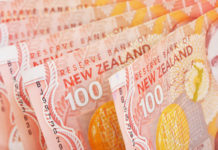Economic data from the US kept investors in a cautious mode yesterday as the latest wave of data showed that the US economic growth was indeed strong at 3.2% for the Q4, but that was slightly lower than the 3.3% penciled in by analysts; consumer spending remained strong while the price indicators were higher than expected. That’s exactly the opposite of what the bulls wanted to see. The S&P500, Nasdaq and Russell 2000 fell and the US dollar index failed to extend gains above the 100-DMA.
Good news from yesterday was that US congressional leaders reached a last minute deal to avert a government shutdown. The discussion will come back in September.
All eyes are on the PCE prints today. The Federal Reserve’s (Fed) favourite gauge of inflation, the core PCE, is expected to print the biggest jump in a year, both 3 and 6-year figures are expected to rise back above 2% after having eased below this level by the end of last year. That would back the uptick that the CPI figures also printed at the beginning of this month and further spoil the dovish Fed expectations. The Fed will probably cut the rates this year, yet a cut before summer won’t be on the agenda if inflation doesn’t continue to ease. Three Fed members repeated yesterday that the timing and the pace of policy easing will depend on data. Activity on Fed funds futures gives around 64% chance for a June cut before the data. Bets could go either way. A figure in line or ideally softer than expected should keep the FEd doves betting for the first rate cut to happen in June, whereas a stronger-than-expected figure could strengthen the hawks’ hand and push the expectation of the first cut to… July.
Elsewhere, the Bank of Japan’s (BoJ) core PCE index came in stronger-than-expected. The USJDPY fell below the 150 psychological mark, as the data revived the idea that the BoJ will exit the negative rate territory sooner rather than later (I can’t tell you what ‘soon’ in sooner means though). One board member at the BoJ said that the case for exiting the negative rates is gaining momentum. If that idea gains traction among traders, we will quickly see the USDJPY snap back to 140.
Here in Europe, the Euro area countries will also release their own inflation numbers throughout the day. Softer than expected inflation data from the European countries should keep the idea that the European Central Bank (ECB) would cut its rates into summer. Yearly figures are seen easing, but monthly figures are seen higher – higher energy prices and rising shipping costs could be to blame. The EURUSD bears are waiting in ambush to send the pair below the 100 and 200-DMA in case of a stronger than expected US inflation data. Note that a stronger US inflation, if coupled with a broad-based dollar appreciation, should delay the ECB cut expectations no matter what the current euro area inflation numbers say – higher dollar would be inflationary.
One place that doesn’t seem to be affected by news is Bitcoin. The coin’s price is rising exponentially since the week started; a unit of Bitcoin traded at $64’000 per coin yesterday. That’s around $5K shy of the ATH recorded back in 2021, and the strength of the rally makes us think that there is rising FOMO aiming the $100K mark. Of course, I am not saying that Bitcoin will rally straight to that level, but enthusiasm will clearly be back if Bitcoin successfully clears the $69K offers. From a fundamental perspective, the price surge makes sense. Supply is limited, demand is surging, hodlers aren’t willing to sell and the arrival of Bitcoin ETFs made the asset class more investable for big players. And indeed, spot Bitcoin ETFs have amassed $6bn since their inception, and BlackRock’s ETF saw a whopping $520 million inflows in a single day. It was apparently the second biggest inflow into a US ETF, all asset classes included. And the potential is huge. If Bitcoin’s correlation with traditional asset classes decrease, and if the price moves happen on sector fundamentals, it would be an interesting diversification asset for traditional portfolios. But you should keep in mind that price moves in cryptocurrencies are driven by a fair amount of speculation and fluctuations could be big. Some already call for a 20% downside correction after the rally is done.
Elsewhere, US crude made an attempt to the $80pb yesterday on news that OPEC+ is considering to extend its production cuts into the Q2. The latter should throw a floor under any selloff, but I’m not sure whether OPEC alone could send US crude above the $80pb sustainably. From a technical perspective, US crude has stepped into the medium-term bearish consolidation zone, above the major 38.2% Fibonacci retracement on September to December selloff, which should in theory pave the way for further gains. If the $80pb is cleared, gains could extend to $82pb. But supply in non-OPEC countries is surging, and the war premium in the Middle East remains low as production hasn’t been affected by tensions so far, therefore the sustainability of gains above the $80pb mark is to be seen.













